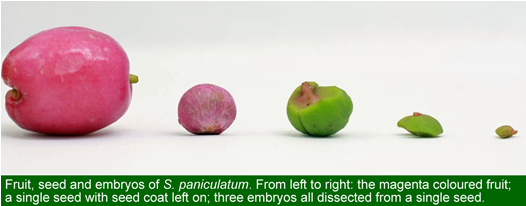
Summary of final report on the Australian Flora Foundation funded project:
Katie A. G. Thurlby1, 2 , William B. Sherwin2 , Maurizio Rossetto1 , and Peter G. Wilson1
1 National Herbarium of NSW, Botanic Gardens Trust, Mrs Macquaries Rd Sydney, NSW 2000
2 School of Biotechnology and BioMolecular Sciences, University of New South Wales, NSW 2052
Grant Details Final Report
The Magenta Lilly Pilly (Syzygium paniculatum), endemic to a narrow strip along the New South Wales coast, is currently listed as vulnerable at both state and national levels. At present management of the species focuses on minimizing currently known threats, such as weed invasion, while little is known about the reproductive biology of the species. S. paniculatum is the only recorded polyembryonic Australian species of Syzygium; polyembryony being the development of multiple (and often asexual) embryos in one seed. Nuclear microsatellite markers were used to investigate the genetic outcome of polyembryony on the reproductive and population biology of the species focusing particularly on the population located on The Entrance Peninsular. Low within-population diversity was found, with low heterozygosity levels and a low level diversity indices when compared to other rare or rainforest species. Multiple embryos from single seeds were found to be identical to the mother. Multiple embryos germinated and survived but one seedling was always significantly taller than all others in the seed but was not considered sexual. It was concluded that the rare S. paniculatum is an apomictic clonal species with extremely low genetic diversity.
